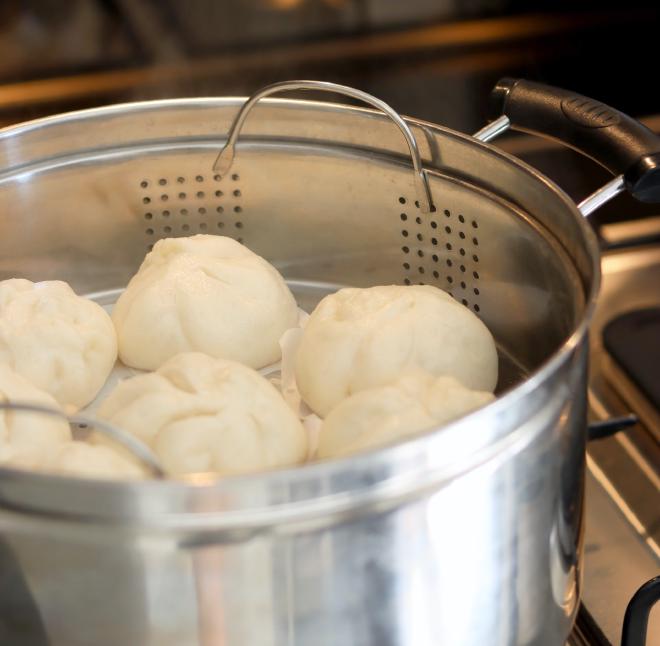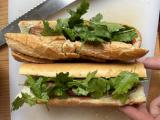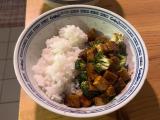- Climate-Friendly Cooking :carrot: /
- Recipes/
- Vegetarian Baos - Steamed Asian Dumplings (in two variations)/
Vegetarian Baos - Steamed Asian Dumplings (in two variations)
Table of Contents
Jump to Recipe
Jump to Carbon Footprint

Baos, sometimes also called bao buns, are steamed Asian dumplings with a filling. Traditionally, they are stuffed with marinated pork belly, but there are now many different variations - not least since David Chang started serving them at his restaurant Momofuku in New York City. The dough for the baos is a simple yeast dough that becomes extremely soft and fluffy when steamed. The combination of this soft shell and the spicy filling is simply superb.
Here are recipes for two vegetarian versions - but of course, the sky’s the limit when it comes to filling! There are also different ways of making the pockets yourself: Some recipes call for them to be shaped like half-open taco shells, rather than closed. In this recipe, I make traditional dumpling pockets that are completely closed.
Baos are steamed in a pot - often a bamboo basket placed inside the pot. To prevent the baos from sticking to the basket, it is best to use a piece of baking paper cut to size. The basket will often hold two or three dumplings at a time: this is about enough for one person, so be prepared to make several batches before you have enough dumplings. You can keep the finished dumplings warm in the oven, for example.
If you don’t have a bamboo basket, you can use an ordinary steamer or buy one from an Asian shop. Pay attention not only to the diameter of the basket but also to its height: for the baos to cook slowly in the steam, you need to be able to put the lid on the pot when the basket is in place. If you don’t have a bamboo basket or steamer, you might want to consider using the steam function on your oven.
This recipe requires a bit of patience - so it’s worth making more than two portions. Baos are also easy to make and freeze: Once steamed, simply allow them to cool and put them in a freezer bag with some greaseproof paper between them. To reheat, simply defrost and steam again for about 7 minutes.
Baos can be eaten on their own with a little soy sauce. If you want a side dish, try kimchi or a light Asian salad.
Recipe #
Vegetarian baos
2 hours
around 15 baos, equivalent to about 2-3 portions
The amount for each filling is enough for all 15 baos: so if you want to make 15 baos but both fillings, halve the amount for each filling.
Ingredients #
Bao dough
- 450 g wheat flour
- 21 g fresh yeast (= half a cube)
- 1/2 teaspoon salt
- 2 tablespoons oil
- 235 g water
Filling variation #1: Veggie mince with vegetables
- 250 g veggie mince
- 1 carrot
- 75 g mushrooms
- 75 g zucchini
- 2 cloves garlic
- 1 tablespoon oil
- 1 g chili
- 3 tablespoons soy sauce
Filling variation #2: Spinach with Asian spices and a dash of soy sauce
- 1 small onion
- 2 cloves garlic
- 1 tablespoon oil
- 300 g spinach (frozen)
- 3 g Japanese spice blend (Shichimi Togarashi), can be replaced with a blend of chili, ginger, cumin, and coriander (not quite the same spices, but this blend also works well).
- 3 tablespoons soy sauce
- 1 tablespoon sesame seeds
Directions #
Dough
- Mix all the ingredients for the dough in a bowl and knead for about 5-10 minutes on the lowest speed. The dough should be very elastic.
- After kneading, shape the dough into a ball, cover the bowl with a clean tea towel and leave in a warm place to rise for about an hour.
- When the dough has risen, place it on a floured work surface and roll out to about 5mm thick using a rolling pin that has also been slightly floured. (It is normal for the dough to be so elastic that it tends to spring back into its original shape).
- Using a glass or small bowl, cut circles from the dough (about 8cm in diameter). Gently roll out the circles with a rolling pin (twice over the dough).
- Gently knead the remaining dough into a ball and repeat the previous two steps (roll out, cut out, briefly roll out the circles) until the dough is used up and you have about 15 circles of dough for the baos.
Filling variation #1: Veggie mince with vegetables
- Heat a little oil in a frying pan and fry the veggie mince until it turns grey.
- Peel and chop the carrot. Chop the mushrooms, zucchini, and garlic. Sauté all the vegetables for about 5 minutes.
- Season with chili and deglaze with soy sauce. Set aside until you are ready to fill the baos.
Filling variation #2: Spinach with Asian spices and a dash of soy sauce
- Peel and chop the onion and garlic. Brown them in a frying pan with oil.
- Add the frozen spinach and cook until tender. If necessary, add a little water to prevent it from burning.
- Season to taste, add the sesame seeds and pour in the soy sauce. Now you are ready to fill the baos.
Filling and steaming
- Take one of the circles of dough in one hand and put about 2 tablespoons of filling on it. Fold the pastry around the filling. Pinch the top together and twist slightly to form a small point. Repeat until you have made all the baos.
- Line the steamer or bamboo basket with baking paper to prevent the baos from sticking. Heat a little water in a saucepan and bring to the boil briefly, then reduce the heat and cover to allow steam to build up in the pan. It is better to use less water and add more if necessary: The grid of the basket on which the buns are placed should not touch the water.
- Place the dumplings in the steamer or bamboo basket. They will open up a little during steaming, so don’t crush them and ideally leave some space. Our bamboo basket holds about 2-3 baos. (It is fine if the baos touch each other slightly, but the basket should not be completely full.) Steam for about 10-15 minutes. Repeat if necessary until all the dumplings have been steamed. The previous batches can be kept warm in the oven at about 50-80 degrees.
Carbon Footprint #
If you convert the amount above into two portions, the estimated carbon footprint is 912 g for the veggie mince and vegetable stuffed version and 649 g for the spinach stuffed version.
This ranks it number 3 out of 57 recipes published on the blog so far in terms of estimated carbon footprint.
In other words, this is the recipe with the third-lowest climate impact published here!! 🥉🥳In the veggie mince and vegetables option, the difference between the mince and the vegetables, such as zucchini, is particularly striking. In the spinach filling, it is worth noting that the frozen spinach in particular has a very good carbon footprint, despite the processing steps required for cooling and maintaining the cold chain.
Here is the graphic for the baos with the first variant of the filling (veggie mince).
Here you can find the graphic for the baos with the spinach filling variant.
Here is the list of ingredients for the baos with the first filling variant (veggie mince):
| ingredient | carbon footprint per kg | carbon footprint (in g) for 2 servings | % of ingredients | % of CO2 emissions |
|---|---|---|---|---|
| Wheat flour | 0.9 | 320 | 44% | 35% |
| Fresh yeast | 1.0 | 17 | 2% | 2% |
| Salt | 1.4 | 1 | 0% | 0% |
| Oil | 3.2 | 51 | 2% | 6% |
| Veggie mince | 1.7 | 338 | 24% | 37% |
| Carrots | 0.1 | 6 | 8% | 1% |
| Mushrooms | 1.3 | 78 | 7% | 9% |
| Zucchini | 0.2 | 12 | 7% | 1% |
| Garlic | 0.5 | 1 | 0% | 0% |
| Oil | 3.2 | 26 | 1% | 3% |
| Chili powder | 1.1 | 1 | 0% | 0% |
| Soy sauce | 0.2 | 8 | 4% | 1% |
| Fry the filling | 9 | 1% | ||
| Steam baos | 44 | 5% |
… and here is the list with the second filling variant (spinach)
| ingredient | carbon footprint per kg | carbon footprint (in g) for 2 servings | % of ingredients | % of CO2 emissions |
|---|---|---|---|---|
| Wheat flour | 0.9 | 320 | 48% | 49% |
| Fresh yeast | 1.0 | 17 | 2% | 3% |
| Salt | 1.4 | 1 | 0% | 0% |
| Oil | 3.2 | 51 | 2% | 8% |
| Onion | 0.2 | 11 | 7% | 2% |
| Garlic | 0.5 | 2 | 1% | 0% |
| Oil | 3.2 | 26 | 1% | 4% |
| Spinach (frozen) | 0.6 | 144 | 32% | 22% |
| Japanese spice blend | 0.2 | 1 | 0% | 0% |
| Soy sauce | 0.2 | 8 | 5% | 1% |
| Sesame | 4.2 | 305 | 1% | 5% |
| Fry the filling | 6 | 1% | ||
| Steam baos | 32 | 5% |


